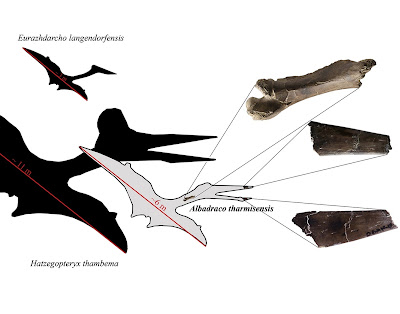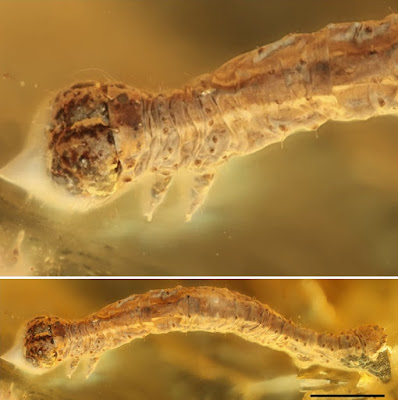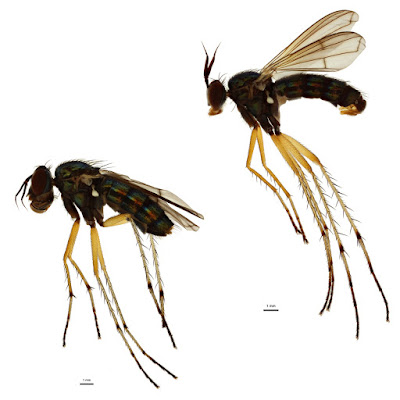[Most Recent Entries] [Calendar View]
Friday, November 22nd, 2019
| Time | Event | ||||
| 3:51a | [Paleontology • 2020] Albadraco tharmisensis • A New Species of Large-sized Pterosaur from the Maastrichtian of Transylvania (Romania)
Highlights: • A new large-sized azhdarchid pterosaur is described. • Although not fully-grown, Albadraco represents a new azhdarchid species. • It is intermediate between giant and medium-sized azhdarchids. • It indicates highly diverse ecosystems from Hațeg Island. ABSTRACT The Upper Cretaceous “Hațeg Island” is not only renowned mostly for its peculiar assemblage of dwarf dinosaurs, but also for its Azhdarchidae pterosaurs including giant specimens (e.g. Hatzegopteryx thambema) and medium-sized ones (e.g. Eurazhdarcho langendorfensis), discovered in the Hațeg and Transylvanian basins of Romania. Here, we report a new species of azhdarchid pterosaur, Albadraco tharmisensis gen. et sp. nov. The material refers to two well-preserved “beak” fragments and a cervical vertebra. These fossils were discovered together in a fossil assemblage in the Maastrichtian Șard Formation, located in the southwestern area of the Transylvanian Basin (Alba District, Romania). The association of a premaxilla and a mandibular symphysis from the same specimen is the first ever reported in Europe. The fourth cervical exhibits the best three-dimensional preservation of any azhdarchid mid-cervical vertebra in Transylvania, as all specimens reported previously are poorly preserved (e.g. in E. langendorfensis) or incomplete like the specimen from Pui with a broken condyle. Albadraco tharmisensis represents a new species of a large–sized azhdarchid from the “Hațeg Island”. Its size fits between that of E. langendorfensis and H. thambema, hence confirming the co-existence of medium, large, and giant–sized azhdarchids during the Maastrichtian in Transylvania. The possibility of Ad. tharmisensis being a young Hatzegopteryx is also discussed. Keywords: Azhdarchidae, beak, Europe, Transylvanian Basin, Maastrichtian Albadraco tharmisensis gen. et sp. nov. Alexandru A. Solomon, Vlad A. Codrea, Márton Venczel and Gerald Grellet-Tinner. 2019. A New Species of Large-sized Pterosaur from the Maastrichtian of Transylvania (Romania). Cretaceous Research. In Press. DOI: 10.1016/j.cretres.2019.104316 | ||||
| 4:25a | [PaleoEntomology • 2019] Eogeometer vadens • Geometrid Caterpillar (Lepidoptera, Geometridae) in Eocene Baltic Amber
Abstract Lepidoptera have little fossilization potential due to the presence of delicate structures and hence are exceptional findings, even in ambers that allow their preservation in sufficient detail for interpretation. From Eocene Baltic amber, the volumetrically largest known deposit of amber, there has been no reliable report of any member of the Macrolepidoptera (informal group of higher moths and all butterflies). Any such lepidopteran fossil would provide insight into evolutionary processes during the Eocene, long after flowering plants had completed their initial radiation. Here, we report on a first geometrid caterpillar from Baltic amber which is described as the oldest evidence for the subfamily Ennominae (tribe Boarmiini) and as one of the oldest records of the currently mega-diverse family. The new finding provides an important calibration point for molecular clock analyses within the family Geometridae and predates the basal divergence of Boarmiini from 32–38 to 44 Mya. It also predates the occurrence of this highly specialized form of caterpillar locomotion that allows for rapid movement. Eogeometer vadens nov. gen., nov. spec Systematics: Order LEPIDOPTERA Linnaeus, 1758 Clade DITRYSIA Börner, 1925 Superfamily GEOMETROIDEA Leach, 1815 Family GEOMETRIDAE Leach, 1815 Genus Eogeometer nov. gen. Etymology: The prefix ‘Eo’ refers to the Eocene, ‘geometer’ to the family name. Eogeometer vadens nov. spec. Holotypus: Specimen SNSB-ZSM-LEP amb002 (Fig. 1) Locus typicus: Amber mine of Yantarni, Russia Stratum typicum: “Blaue Erde” Horizon (Upper Eocene – Lower Oligocene) Etymology: The species name ‘vadens’ - “walking” refers to the looping manner of locomotion. Repository: Bavarian State Collection of Zoology, Munich, Germany; accession number SNSB-ZSM-LEP amb002. Diagnosis of genus: The genus Eogeometer is established for this Eocene geometrid caterpillar presumably belonging to the tribe Boarmiini. A differential diagnosis will be given when more Eocene geometrids will become known. Attribution to any extant geometrid genus would be highly speculative. The amber larva shares the character combination of supposed conifer-feeding (see below) and a conspicuous semicircular anal plate with only a few extant geometrid larvae (see discussion), which, however, do not show a longitudinal stripe pattern. Description of species: The looping caterpillar is 5 mm in length; the body is long and approximately cylindrical, smooth, but with transversal wrinkles. Along the uppermost ventral side of thorax and abdomen runs a longitudinal protruding and darkish stripe. The head diameter is about 1.5 times the diameter of the body, hypognathous and rounded; both parts of the head capsule show a symmetric spotty dark and light pattern. The legs are well developed (first right leg is missing); prolegs are well developed at abdominal segments A6 and A10 (one proleg of A10 is broken off and is preserved at some distance to the head of the caterpillar); only rudimentary prolegs are present at abdominal segment 5. There is a shield-like protrusion from the ventral side of A10. The setae D1, D2 are positioned at the edge of the longitudinal, dark protrusion. L1, L2 and SV1 are present in lateral positions. MD1, MSD1, MSD2, SD1, SD2 are seemingly absent (Setal map as Supplementary Information). Taphonomy: The geometrid inclusion occurs within a flat piece of non-autoclaved Baltic amber with dimensions 30 mm by 20 mm, and a height of 4 mm. At one edge, about 5 mm were removed from the sample for IR analysis. The caterpillar is situated centrally within the amber, close to an internal boundary of two resin flows. The only syninclusions preserved adjacent the caterpillar are two different but poorly preserved mites. Some pyrite is present in cracks of the amber. Thilo C. Fischer, Artur Michalski and Axel Hausmann. 2019. Geometrid Caterpillar in Eocene Baltic Amber (Lepidoptera, Geometridae). Scientific Reports. 9: 17201. DOI: 10.1038/s41598-019-53734-w Erste Großschmetterlings-Raupe im Baltischen Bernstein entdeckt idw-online.de/-CxmEAA | ||||
| 10:05a | [Entomology • 2019] NGS-barcodes, Haplotype Networks Combined to External Morphology Help to Identify New Species in the Mangrove Genus Ngirhaphium Evenhuis & Grootaert, 2002 (Diptera: Dolichopodidae: Rhaphiinae) in Southeast Asia
Abstract A review is given of the Ngirhaphium species of Southeast Asia and two new species are described from Thailand. Ngirhaphium meieri Samoh & Grootaert, new species is described from a mangrove in Takua Pa district, Phang Nga Province, peninsular Thailand. NGS-barcodes (313 bp) are congruent with traditional taxonomic delimitation. Ngirhaphium caeruleum Grootaert & Puniamoorthy sensu lato seems to consist of a species-complex with 32 haplotypes and has a wide distribution in the southern part of the South China Sea. There is a 4.2 % genetic difference between the Thai/Cambodian population and the Singapore/Brunei populations in N. caeruleum: despite the many haplotypes and differences in male terminalia, the Thai and Cambodian haplotypes formed a haplotype group, while the Singapore and Bruneian specimens formed another haplotype group. Nonetheless, the Thai population is morphological distinct enough to be considered a morpho-species: it is here described as N. thaicum Samoh & Grootaert, new species. An updated distribution of the six Southeast Asian Ngirhaphium species is given with additional taxonomic notes, a key to the species and a phylogenetic diagram. We find that the Andaman Sea coast to be the most diverse with four species while the South China Sea region has only two species both belonging to the caeruleum species complex. N. sivasothii Grootaert & Puniamoorthy is common and occurring from Singapore up to the Thai coast of the Andaman Sea, with 28 haplotypes. Remarkable in all species is the limited distribution of the haplotypes, where most seem endemic to a limited area and thus provide information about the origin of the distribution. Key words: Dolichopodidae, Ngirhaphium, NGS-barcodes, peninsular Thailand TAXONOMY: Family Dolichopodidae Subfamily Rhaphiinae Genus Ngirhaphium Evenhuis & Grootaert Ngirhaphium Evenhuis & Grootaert, 2002: 310. Type species by original designation: Ngirhaphium murphyi Evenhuis & Grootaert, 2002. Ngirhaphium caeruleum species complex
Ngirhaphium thaicum Samoh & Grootaert, new species Distribution. Trat, Prachuap Kirikan, Chumphon, Surat Thani Province, and Cambodia. Gulf of Thailand (South China Sea). Remarks. This is one of the largest Ngirhaphium species. They prefer open areas without canopy cover and with soft mudflat. Ngirhaphium meieri Samoh & Grootaert, new species Etymology. The species is dedicated to Rudolf Meier, head of Evolutionary Biology Laboratory, Department of Biological Sciences at the National University of Singapore (NUS), who provided us an opportunity to learn and do a molecular study of the marine dolichopodid flies. Distribution. Phang Nga and Ranong provinces, Thailand, Andaman Sea (Indian Ocean). Remarks. The new species is morphologically similar to N. sivasothii and even more to N. chutamasae. Differences can be found in the key to the Southeast Asian species here below. Ngirhaphium caeruleum Grootaert & Puniamoorthy, 2014 Ngirhaphium chutamasae Samoh, Boonrotpong & Grootaert, 2015 Ngirhaphium murphyi Evenhuis & Grootaert, 2002 Ngirhaphium sivasothii Grootaert & Puniamoorthy, 2014 Abdulloh Samoh, Chutamas Satasook and Patrick Grootaert. 2019. NGS-barcodes, Haplotype Networks Combined to External Morphology Help to Identify New Species in the Mangrove Genus Ngirhaphium Evenhuis & Grootaert, 2002 (Diptera: Dolichopodidae: Rhaphiinae) in Southeast Asia. RAFFLES BULLETIN OF ZOOLOGY. 67; 640–659. |
| << Previous Day |
2019/11/22 [Calendar] |
Next Day >> |










